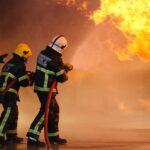Passengers on an American Airlines Boeing 737 evacuated onto the wing after an engine caught fire at Denver International Airport on Thursday, March 13, 2025.
The Federal Aviation Administration (FAA) stated, “American Airlines Flight 1006 diverted to and landed safely at Denver International Airport around 5:15 p.m. local time on Thursday, March 13, after the crew reported engine vibrations. After landing and while taxiing to the gate an engine caught fire and passengers evacuated the aircraft using the slides.” The full statement is available in an official release.
Video footage taken by witnesses and passengers showed flames coming from one of the aircraft’s engines under the right wing. Emergency slides were deployed, and some passengers exited onto the wing. Dense smoke filled the area around Terminal C at gate C38.
Twelve passengers sustained minor injuries and were transported to local hospitals. Airline officials report all have since been released.
Alexandria Cullen, a press assistant for Colorado Congressman Gabe Evans, stated that her mother was one of the 172 passengers on the flight. “My mom was on this flight. THANK YOU GOD that they are alive,” Cullen wrote on social media.
A witness described the scene as “nerve-wracking, terrifying and horrific,” reflecting the experiences of those present.
American Airlines confirmed that all 172 passengers and six crew members were safely evacuated and transported to the terminal. The airline expressed gratitude to its crew, the DEN team, and first responders for their prompt actions.
Questions have arisen about emergency response procedures, as fire crews were not present when the plane landed. Aviation experts indicated this was because a formal emergency had not been declared initially, despite the engine vibrations reported by the pilot.
Investigators are exploring several possible causes for the engine fire, including a punctured fuel line or mechanical failure. The National Transportation Safety Board (NTSB) has sent a team to inspect the aircraft, interview witnesses and crew, and gather relevant data.
The NTSB expects to issue a preliminary report within 30 days, with a final determination of the cause likely taking 12-24 months. The Boeing 737-800 remains at Denver International Airport for further investigation.
This incident occurs amid mounting concerns about aviation safety following several recent incidents, including crashes in Toronto, Ontario; Alaska; Philadelphia, Pennsylvania; and near Washington, D.C. Engine issues have also affected flights, such as a United Airlines flight in Houston, Texas, and a FedEx cargo plane in New Jersey.
Days after the Denver incident, on March 17, 2025, another American Airlines flight encountered potential engine problems. Flight 1603, from Miami, Florida, to Guatemala City, returned to Miami International Airport shortly after takeoff. Eyewitness Jake Fletcher reported hearing an explosion and seeing flames from one of the plane’s engines.
“Take a long, hard look at what’s going on with their airplanes,” Fletcher remarked, expressing concern about the two incidents occurring so closely.
Despite these issues, aviation safety experts emphasize that air travel remains one of the safest transportation modes.
Dr. Hassan Shahidi of the Flight Safety Foundation commented on air travel in the United States, stating, “In 2024 we had a billion people travel by air in the U.S. Thousands of airplanes depart and land every day, with trained pilots and air traffic controllers who are doing their jobs well. But that said, there are concerns.”
Industry expert Dr. Daniel Adjekum, who has over 20 years of experience in aviation safety management, expressed caution about potential staffing reductions in the sector, noting, “This is not a time to be cutting stuff and to be laying people off.”
Aviation safety data indicates there were 1,417 aviation crashes in the United States in 2024, with 258 being fatal. In 2025, there have been 99 aviation accidents so far, resulting in 14 fatalities. While these numbers have declined from previous decades, experts note that pilot error (53%), mechanical failure (21%), and weather conditions (11%) continue to be primary factors in aviation incidents.
Operations at Denver International Airport resumed normally after the incident, with the affected gate reopening the following day.

